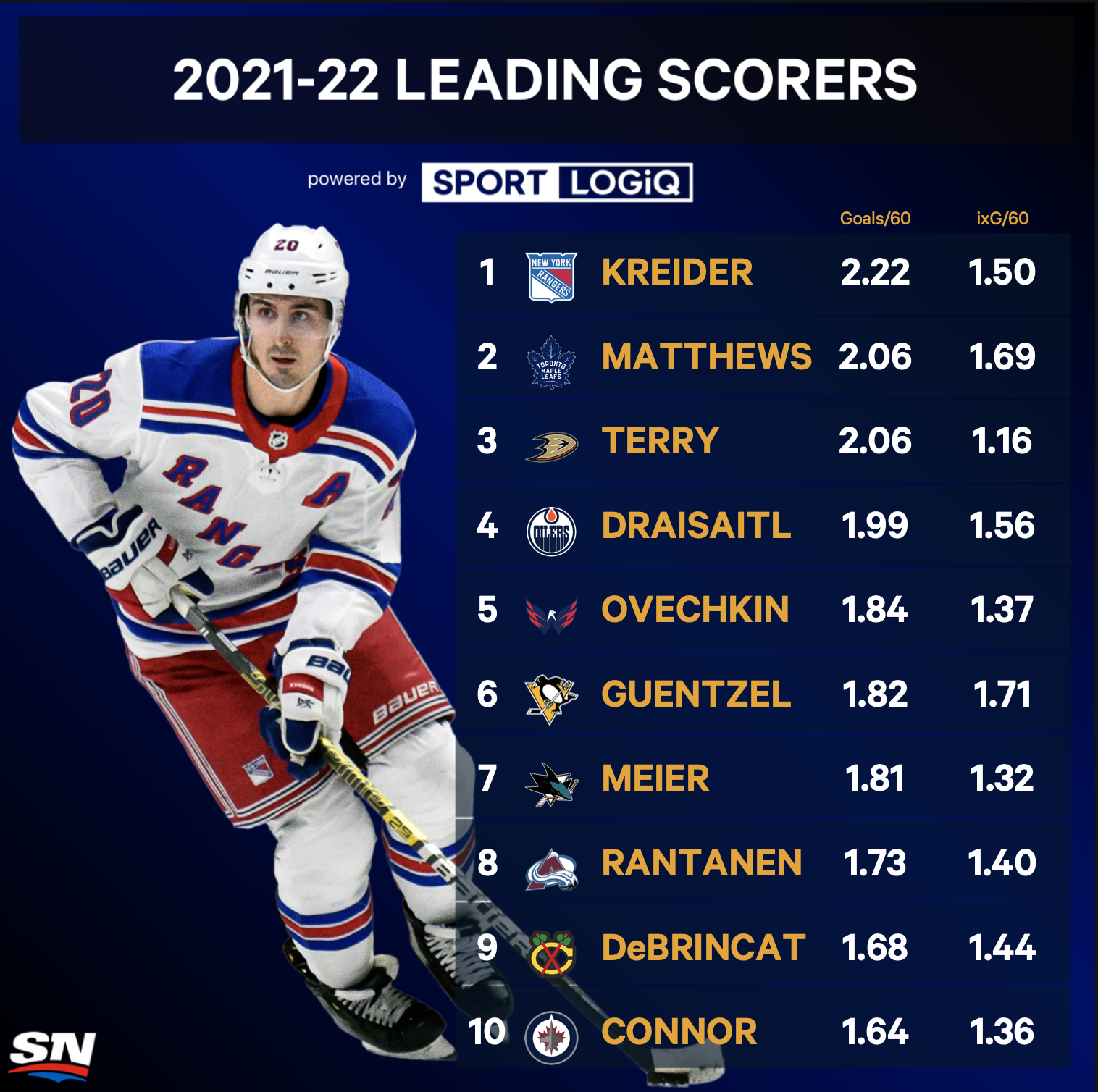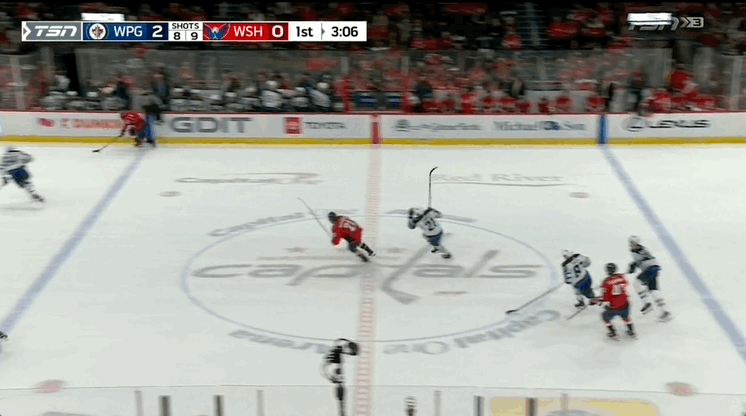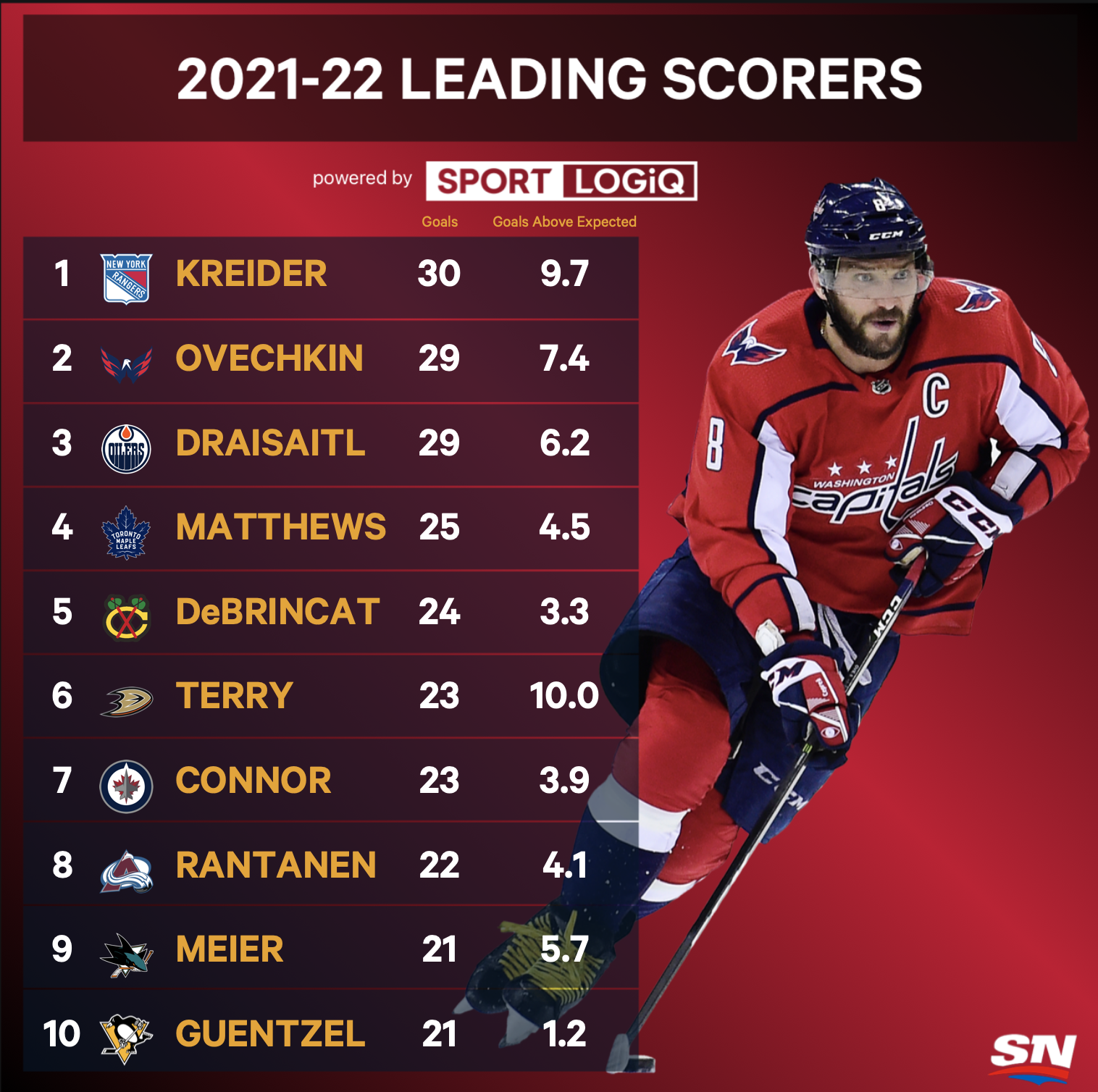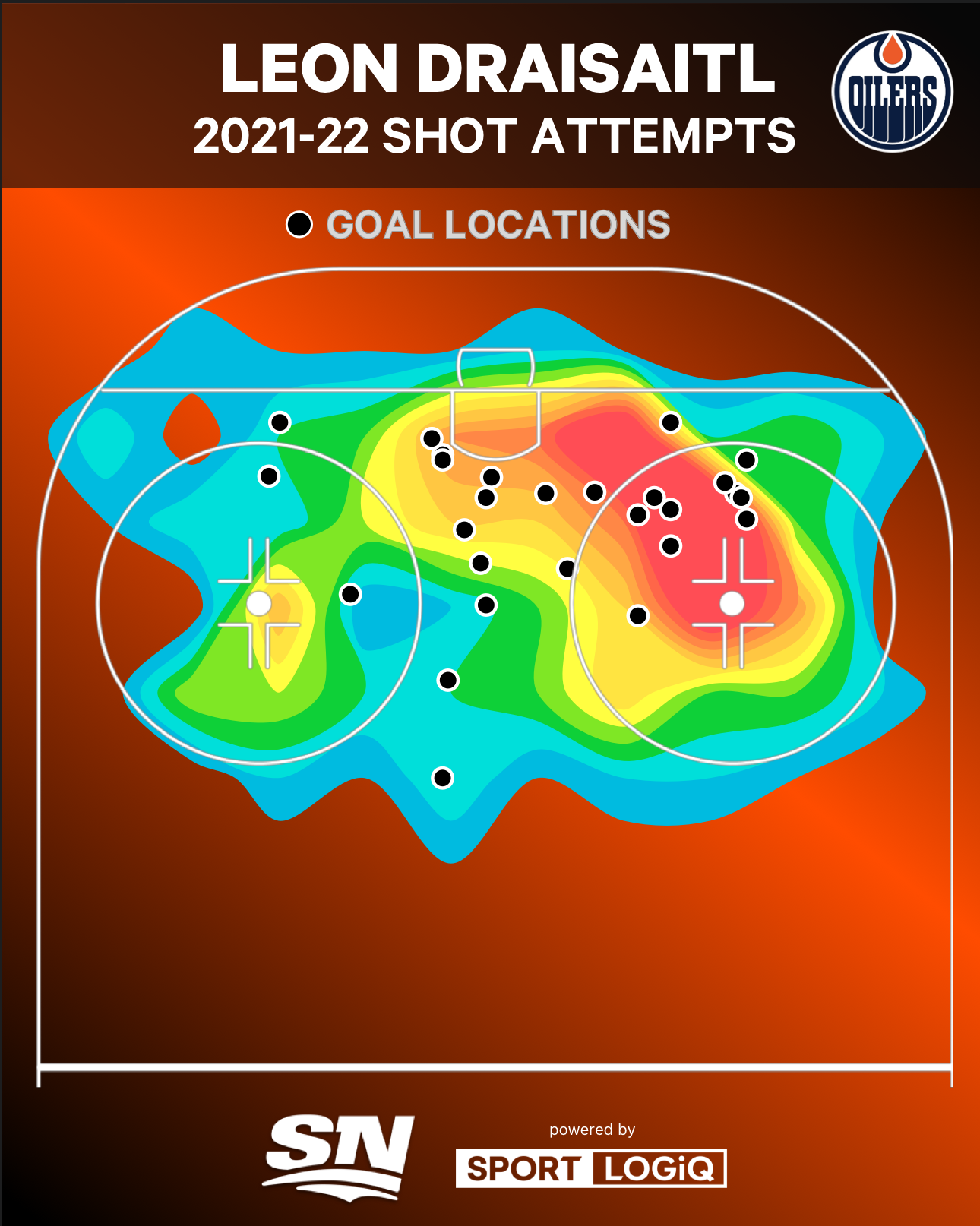Chris Kreider tallied goal No. 27 against the Coyotes to pull even with Alex Ovechkin on Saturday night. His next score put him ahead of the rest of the league.
At the same time, Ovechkin was facing off against the Senators. Less than two minutes into the third period, he scored goal No. 28 to even the race again.
Back in New York, Kreider completed the hat trick to set a career high with 29 goals. But that scoring lead lasted only minutes until Ovechkin netted his second of the game.
Hours later, Leon Draisaitl stayed on their heels with a two-goal game against the Flames, bringing him up to 28 on the season.
Monday night, while Ovechkin and the Capitals were shut out, Kreider became the first player this season to reach the 30-goal milestone. Draisaitl notched his 29th Tuesday night against the Canucks, pulling him into a tie for second place with Ovechkin.
Between Kreider, Ovechkin, Draisaitl and Auston Matthews in fourth place, there’s intrigue in the goal-scoring race as most teams near the midpoint of 2021-22. What might it look like when the second half of the season concludes?
Along with wild cards in the mix heating up down the stretch, the Rocket Richard race will likely come down to the sustainability of the leading scorers. Let’s dive in.
Chris Kreider
There were concerns that Kreider’s game may have started to decline going into this season, but his goal scoring is proving otherwise.
The winger can be found planted in front of the crease, tipping and deflecting shots into the net; his power-play deflection shot attempt rate puts him fifth in the league, and his scoring puts him first. Of his 30 goals, 15 have been scored on the man-advantage -- and those 15 make up half of the team’s power-play scoring. Between Kreider's coordination and the team’s frequent shooting, he may be able to keep that up.

While he can tip and deflect shots at 5-on-5, most of Kreider's scoring comes from his wrist shot there. Whether it’s off the cycle or from his speedy skating, the common theme between most of his shot attempts is the location. In all situations, he’s second in the league with 1.92 goals per 60 from the slot.

Among the top-10 goal scorers in the league, no one’s played more than Kreider's and Ovechkin’s 43 games. However, when accounting for ice time, the Rangers’ forward maintains his top slot with 2.22 goals per 60 (relative to the entire league, he’s fourth).

Sustainability is the biggest question, considering how much he’s scoring above expected -- almost 10 goals more. Kreider’s expected to be closer to 20.3 goals (that xG total ranks fifth in the league); with 20 goals in 43 games, he’d be closer to a 38-goal pace across 82 games. That’s without factoring in his hand-eye coordination on those tips and deflections, or his shooting talent on those wristers.
Finishing ability can easily close the gap between expectations and reality, and Kreider was one of the best finishers in 2021. But this wide of a gap may introduce doubt into his 57-goal pace over 82 games. Instead, it may be somewhere closer to the middle between expectations and reality, which would come in around 48 goals. That still should keep Kreider toward the top of the league, but maybe not enough to finish first based on some of the other elite shooters in the conversation.
Alex Ovechkin
Ovechkin is one of the greatest goal scorers of all time. But at 36 years old, there was some doubt whether he could reach the heights of years past. With 29 goals in 43 games, he’s on pace to score 55 (!) in 82 games -- a mark he hasn’t reached since 2008-09.
What’s interesting about Ovechkin’s season, especially compared to years past, is that it took him time to hit the back of the net with his signature one-timer. But that didn’t slow down his scoring -- Ovechkin was still at the top of the charts because he was finding success in a variety of other ways.

Of course, as to be expected, his one-timer is back in action. It was inevitable; no matter how much he leans on that shot (and as the heat map shows, he uses it a lot), opponents can’t stop it.

Ovechkin’s shot is known for its accuracy, but also his frequency. In all situations, he’s fifth in shot attempt rate among forwards with 24.8 attempts per 60 minutes. And no forward takes more one-timers than Ovechkin (9.14 per 60). While he can shoot from outside that home plate area, 45 per cent of his high shot rate comes from the slot area, which rates out to 11.2 attempts per 60, landing him 11th in the league.
Considering the value of his shots (and pre-shot movement), Ovechkin is expected to be closer to 22 goals (his 21.6 expected goal total is second-highest in the league). That’s what the ‘average’ shooter would be closer to in his position. That total at this point in the season would put him on pace for 42 goals in 82 games. But Ovechkin's lethal finishing has to come into consideration, which is what’s earned him those 29 goals and makes the case for him sticking in this race all season long.

Leon Draisaitl
With 29 goals in 38 games, Draisaitl is on a ridiculous 63-goal pace that would crush his previous high of 50 from 2018-19. Can he actually reach that?
Unlike Ovechkin, Draisaitl isn’t nearly as frequent of a shooter. In all situations, he generates 16.8 shot attempts per 60; that leads the Oilers, but puts him 67th in the league. What he lacks in shot volume, he doesn’t quite make up in quality, either -- Draisaitl's slot shot rate is down at 81st in the league. That stands out in particular at 5-on-5, where his shot rate puts him fifth in Edmonton.
Where he shines in particular is the power play. Draisaitl attempts about 36 shots per 60 minutes on the man-advantage which leads the team and ranks 14th in the league. About 51 per cent of those shots are one-timers, which he generally takes from the right side, giving him an ideal angle for his left-handed shot. Plus, he does generate some slot shots in those situations, too.

So what Draisaitl lacks at 5-on-5, his play on the man-advantage can compensate for. He shoots from the off-wing and he relies on the one-timer which is one of the most dangerous shots. It doesn’t hurt that on the power play he plays almost all of his time with an elite passer in Connor McDavid (unlike 5-on-5 play, where they’re only together about 35 per cent of the time). Overall, no one moves the puck around the offensive zone as much as the Oilers; and few make as many lateral passes, which only improves Draisaitl's shot quality.

All together, that contributes to a league-leading 22.8 expected goal total that would put Draisaitl on pace for 49 goals across a complete season. His shooting talent only increases that.
Shooting at 22 per cent does raise a red flag, but he generally is on the higher end of that spectrum anyway; this season is just slightly more inflated than his average (17.6). But if the team’s scoring or power-play production starts to trend in the wrong direction, it may get dicier for Draisaitl to hit the ceiling he appears to have.
Auston Matthews
Like Ovechkin, Matthews is a volume shooter; his shot attempts in all situations put him eighth in the league at 22.3 per 60. Most of his shots, and almost all of his goals, fit in that home plate area in front of the net.
About 62 per cent of Matthews' shot attempts come from the slot. No one creates quality chances at as high of a rate as Matthews in Toronto; his 13.9 slot attempts per 60 in all situations lead the league. Not only does he produce scoring chances off the cycle on the power play, but at a top-10 rate at 5-on-5, too.
The Leafs centre doesn’t just shoot from the slot at a high rate, he finishes: his slot goals per 60 rate of 1.98 in all situations leads the league.

Matthews’ game is only helped by who he plays with; he spends the majority of his 5-on-5 and power play time alongside a skilled passer in Mitch Marner. The winger ranks 15th in offensive-zone pass attempts and third in passes to the slot in all situations.
Having more than one offensive threat on the ice makes Toronto tougher to defend. But what really makes Matthews thrive is his quick hands, deception and variety. His goals break down to 11 wrist shots, three snap shots, five backhands, three tip-ins and one wraparound. That contributes to a 2.06 goals per 60 scoring rate that puts him eighth in the league among all skaters.

Matthews' scoring chances (and the passing that precedes them) contribute to his fourth-ranked expected goal total of 20.5. He moves even higher when accounting for ice time with 1.69 per 60. The pivot has scored only 4.5 more goals than expected, which makes carrying on at this pace seem even more feasible. Having missed three games so far this season, Matthews is on pace for 56 goals.
Seeing as he’s genuinely creating some of the best quantity and quality shots, it’s not unrealistic to project him finishing at the top of the league when the regular season wraps.
Data via Sportlogiq
